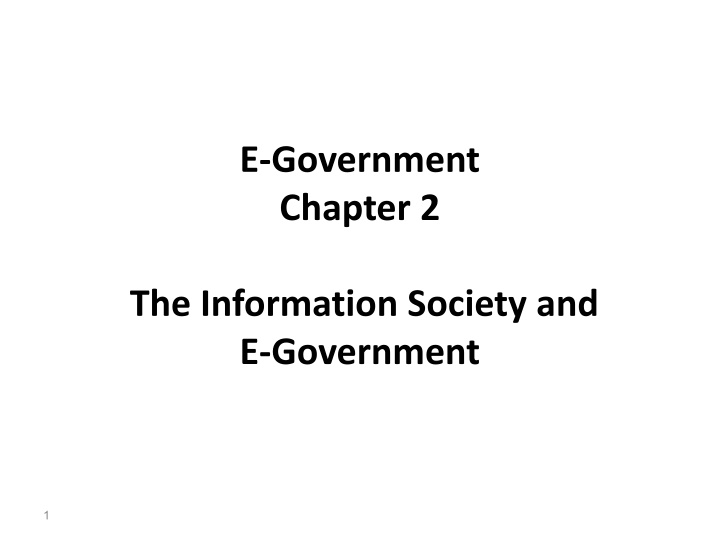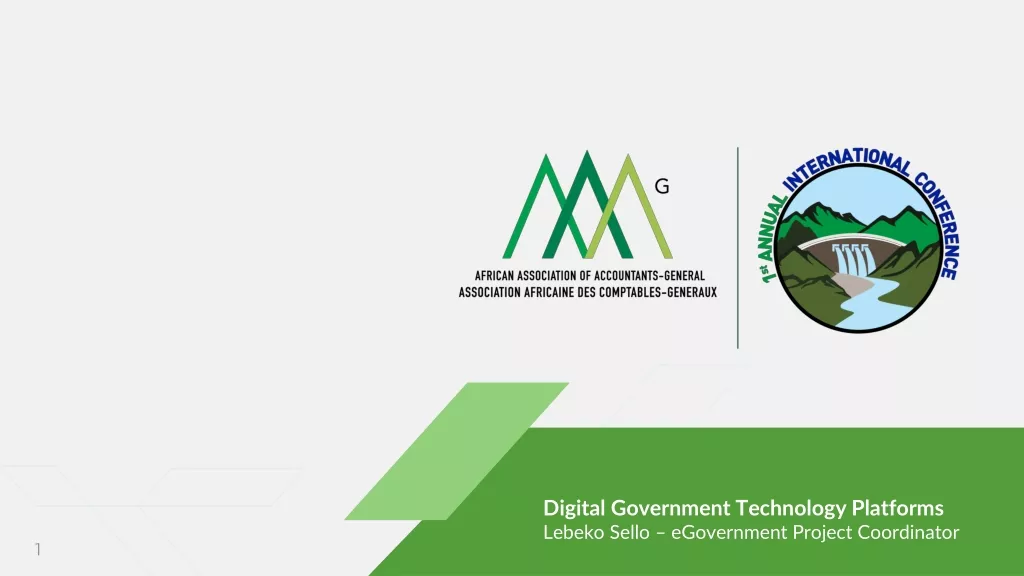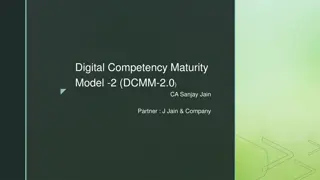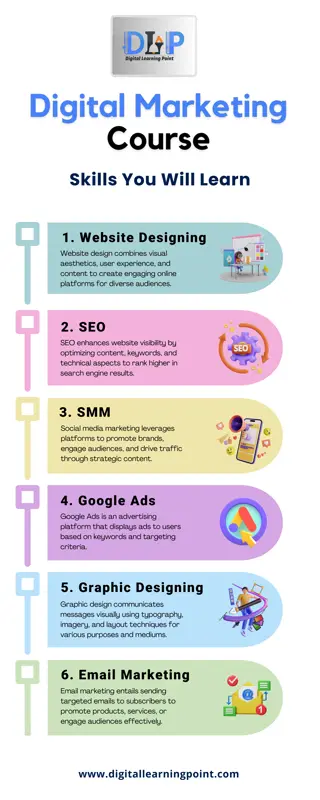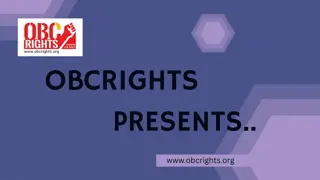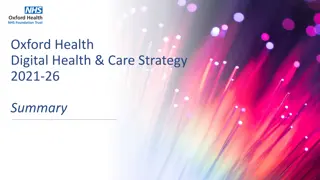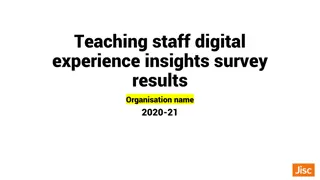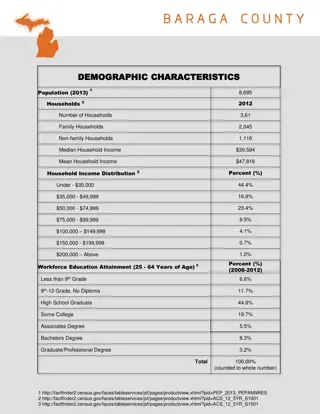E-Government in the Digital Age
The development of information and communication technologies over the past 50 years has significantly influenced the transformation of society and the economy. From the introduction of DOS/360 by IBM to the creation of ARPANET and the intervention of the microprocessor by Intel, technological innovations have reshaped the telecommunications, computing, entertainment, and media industries. The evolution of interconnected technologies, including personal computers and mobile phones, has paved the way for the digital revolution, impacting various sectors and facilitating the emergence of e-government initiatives.
Download Presentation

Please find below an Image/Link to download the presentation.
The content on the website is provided AS IS for your information and personal use only. It may not be sold, licensed, or shared on other websites without obtaining consent from the author.If you encounter any issues during the download, it is possible that the publisher has removed the file from their server.
You are allowed to download the files provided on this website for personal or commercial use, subject to the condition that they are used lawfully. All files are the property of their respective owners.
The content on the website is provided AS IS for your information and personal use only. It may not be sold, licensed, or shared on other websites without obtaining consent from the author.
E N D
Presentation Transcript
E-Government Chapter 2 The Information Society and E-Government 1
2 The Information Society and E-Government So far, technological innovations have always shaped the development of economy and society. Impact of digitization : The digital age, also called digital revolution, which was initiated through the development of the multimedia market leads to a fundamental change of existing structures in the telecommunications, computing, entertainment, and media industry. 2
2.1 The Development of Information and Communication Technologies To understand the underlying evolution of the information society, we have to take a look at the information and communication technology development over the past 50 years. 3
2.1 The Development of Information and Communication Technologies In 1966 IBM introduced the Disk Operating System (DOS/360) for its mainframes. This was the first system that allowed batch processing (executing a series of function commands or programs without rebooting the mainframe or other manual intervention). Only three years later, Paul Baran and Donald Watts created ARPANET, the ancestor of the Internet. This was followed by another milestone in the development of information and communication technologies, the intervention of the microprocessor by Intel. 4
2.1 The Development of Information and Communication Technologies Based on these previous steps, IBM introduced the first personal computer and Motorola presented the first commercial mobile phone. These were the main technological breakthroughs that enabled the development of interconnected information and communication technologies that we know today. 5
Figure 4 Information and Communication Technology Development (1) 6
2.1 The Development of Information and Communication Technologies Given the first network technologies and users, who possessed the necessary hard and software, information technology in general gained more and more commercial interest. In this context, Microsoft released Windows 1.0, a user- friendly operating system that applied a graphical instead of command line interface, to conquer the personal computer market. At the same time, Steve Case founded Quantum Computer Services, which was renamed to America Online (AOL) three years later, and around the year 2000 was the world s largest Internet provider possessing more than 30,000,000 paying customers. 7
2.1 The Development of Information and Communication Technologies With the beginning of the World Wide Web in 1989, the starting point of interconnected networks was set and the digitalization trend picked up speed( ). Big enterprises, such as SAP releasing SAP/R3 in 1993, had to react to provide network compatible software, and young entrepreneurs like Jeff Bezos, who founded amazon.com in 1994, were first movers in the Internet and e-business world. SAP/R3 : software information system designed to coordinate all the resources, information, and activities needed to complete business processes 8
2.1 The Development of Information and Communication Technologies A year after the establishment of amazon.com, eBay Inc. was founded by Pierre Omidyar and quickly became the largest online market place for private and commercial traders. As people started to use the Internet more intensively, the demand for online mobility increased, too. Thus, in 1996 Nokia introduced the first smartphone, which up to now has become a commodity in the mobile phone market. 9
2.1 The Development of Information and Communication Technologies 1998 was the founding year of Google Inc. At the end of the 1990s, Deutsche Telekom company started marketing broadband connections and in 2001 Manx Telecom company introduced the first UMTS network on the Isle( ) of Man. This technology is regarded as a milestone in mobile Internet. 10
2.1 The Development of Information and Communication Technologies Ongoing technological progress led to increasing bandwidth and thus a continuing rise in data transmission rates, which allowed the provision of new online services, such as music or video distribution. A milestone in online music distribution, for example, was the media library and player iTunes, which was released in 2001 and soon became the leading portal in digital music marketing. Moreover, completely new services like Facebook, an online social network, were suddenly realizable. 11
Figure 5 Information and Communication Technology Development (2) 12
2.1 The Development of Information and Communication Technologies So far, wired as well as wireless Internet connections are constantly becoming faster, enhancing online service provision at home and on the way. In the US, for instance, the T1 cable was introduced in 1956. Then in 1978 ISDN revolutionized communication and in 1993 ADSL and in 1995 VDSL again brought along major break through in online data transmission. Integrated Services Digital Network (ISDN) is a set of communication standards for digital transmission of voice, video, data, and other network services. Asymmetric digital subscriber line (ADSL) a data communications technology that enables faster data transmission over telephone lines . Very high-speed digital subscriber line (VDSL): providing data transmission faster than ADSL. About ten years later, the VDSL2 standard, which promised increased speed and better performance, was defined and in 2009 the first LTE networks were put into commercial operation. Long-Term Evolution (LTE) is a standard for wireless broadband communication for mobile devices. 13
2.1 The Development of Information and Communication Technologies These information and communication technology developments provided the technological basis for the global system of interconnected computer networks called Internet, which in 2014 already showed more than 3 billion users. 14
This means that already four out of ten people worldwide use the Internet, representing a growth of 741% since 2000. 15
2.2 The Information Society and its Development with personal computers becoming a commodity( ) and the advent( ) of the Internet, the concept of the information society received increasing attention. The world entered a new technological paradigm( ) by making use of globally networked information and communication technologies. This is a key reason for a set of related social transformations that have taken place all around the world during the past three decades. However, what has changed is not the role( ) of knowledge or information, but rather the availability and application of new information and communication technology. 16
2.2 The Information Society and its Development According to Castells (2000), this new economy we are living in is characterized by the following three features: 1. It is informational, meaning that information management and knowledge creation capacities are main determinants for competitiveness for all economic participants. 2. It is global, economic units can communicate and coordinate their strategic and operative activities in real time on a global scale. 3. It is networked, meaning that economic units are interconnected. 17
2.3 E-Government Development Applying new information and communication technologies to the public sector environment promised to enhance public administration productivity and to satisfy citizen demands for online information and service provision. This was the starting point for an increasing integration of these technologies into governance systems and processes and public authorities began to digitally provide information and services to citizens and businesses. 18
2.3 E-Government Development This novel form( ) of service provision was called electronic government or e-government that based on its innovative nature and expected potential quickly received increasing attention( ) in the public administration and management practice as well as in science. The development of e-government is presented in a two-step approach in the following. First, we outline its progress in practice and second, we demonstrate the topic s evolution in academic research. 19
E-Government in Practice In the US, the High Performance Computing Act( ) of 1991 (HCPA) laid( ) the initial groundwork( ) for making developments like e-government possible and led to the elaboration( ) of the National Information Infrastructure (NII)( ), which was proclaimed( ) in the Agenda for Action of the Clinton Administration. Until that time, information and communication policy did not play a major role in US-internal politics( ). 20
E-Government in Practice However, in 1993 the American government started to build up the so-called information superhighway( ), changing the conditions and the relation between politics, media( ), and the public. With this initiative( ), the USA started to make collective, nationwide( ) use of then novel information and communications technologies and popularized( ) as well as commercialized( ) digital networks. 21
E-Government in Practice A major e-government breakthrough( ) from an implementation perspective happened in 2001. The Office of Management and Budget Director initiated an e-government interagency taskforce( ) to elaborate( ) an action plan( ) for implementing the e-government vision as advised( ) by the President. The e-government taskforce identified 25 high- payoff( ), nationwide( ) projects with an estimated savings potential of several billion dollars. 22
E-Government in Practice The projects were allocated to five areas: (1) government-to-citizen, e.g., elaboration( ) of one-stop portals, (2) government-to-business, e.g., e-tax, (3) government-to-government, e.g., disaster assistance and crisis response( ), (4) internal efficiency and effectiveness, e.g., e-payroll or e- training, and (5) cross cutting initiatives( ) addressing barriers( ) to e-government success, e.g., as e-authentication. 24
E-Government in Practice On the 17th of December 2002 the E-Government Act of 2002 was enacted( ). Its main purposes were the improvement of management and promotion( ) of public online service provision as well as the establishment( ) of a Federal Chief Information Officer( within the Office of Management and Budget. ) It represents the political and legal foundation( ) for all following e-government initiatives( ) in the US. 25
E-Government in Practice In 2009 President Barack Obama signed the Memorandum( ) for the Heads of Executive Departments and Agencies on Transparency( ) and Open Government. In this document, he proclaims( ) a political concept of transparency, participation, and collaboration, as well as an improvement in efficiency and effectiveness. This is a clear statement for the future of e-government from an US perspective. In a similar way, other countries started their own programs to build digital communications networks. 26
E-Government in Practice A forerunner( ) in electronic government services is South Korea, which already enacted( ) the Computer Program Protection Act and Supply and Utilization( ) of Computer Network Act in 1986 to secure network technology and infrastructure. By doing this, the country early set a clear digital focus and thus became one of the first movers in information and communication technology infrastructure development. 27
E-Government in Practice In the beginning of the new millennium, South Korea committed itself to promote( ) e-government by starting various initiatives( ) under the Promotion( ) of Digitalization of Administrative: 1) Work for E-Government Realization( ) Act, 2) the Participatory( ) Government's Vision and Direction of E-Government, 3) and the E-Government Roadmap, in which South Korea specifically formulated their vision of attaining( ) the world s best e-government. 28
E-Government in Practice This aim was pursued( ) through four specific performance initiatives( ): 1) increase online public services to 85%, 2) become one of the top 10 countries for business support competitiveness, 3) reduce visits for civil service applicants( ) to a maximum of three visits per year, 4) and raise the e-government utilization( ) rate to 60%. In 2008 South Korea established the Master Plan for National Informatization( ), which consists of 12 e-government improvement initiatives. These initiatives aim to further enhance the openness( ), sharing, and cooperation( ) of the Korean e-government environment. 29
E-Government in Practice China started its information and communication technology development with the definition of the Golden Projects in 1993, which refers to a pool of initiatives( ) that are carried out by the government to enhance electronic business, government, and governance( ). Examples are: the Golden Bridge Project, which concentrates on the diffusion ( ) of commercial internet service, the Golden Macro Project, which focuses on the advancement of governmental information sharing, or the Golden Shield Project, which refers to increasing police efficiency and public security. 30
E-Government in Practice The enthusiastic( ) discussion of building an information superhighway( ) in the US and the developments in other countries were closely followed in Japan. Here, the Ministry of Posts and Telecommunications( ) pushed a plan to develop an advanced information and communication network that supports virtually unlimited media transmission throughout the country. 31
E-Government in Practice Since Japan believed that they had fallen( ) behind the US with respect to the broadband Internet infrastructure, this plan became a cornerstone of the information and communication infrastructure development. Thus, in 1995 Japan integrated( ) the Basic Policy for the Promotion( ) of Advanced Information and Communication Society and developed the Master Plan for Promoting Government- Wide Use of IT. The three pillars( ) of this digital communication network plan were multimedia, information infrastructure, and fiber optics.( ) 32
E-Government in Practice In this context( ), the government of Japan promoted( ) government digitalization to respond to the society s rising interest in electronic provision( ) of government information and public services. Hereby( ), the Japanese government made this project a top national priority and also provided interest-free loans( ) to financially support necessary investments. 33
E-Government in Practice In 2001 the e-Japan Priority Policy Program was started, which aimed to create the world s most advanced information and telecommunications network. Key targets of this program were the promotion of education, learning, and human resources development, the facilitation( ) of electronic commerce, and the digitization of public administration and management areas. 34
E-Government in Practice A year after its initiation( ), Japan enacted( ) the Law Concerning( and Communications Technology for Administrative Procedures( ), in which the government provided a legal framework for e-government. ) the Use of Information Given these initiatives ( ), Japan made quick progress in advancing its digital network technologies and is now listed among the top 20 of the most developed( ) countries in the field of information and communication technology in the world (see Table 4). 35
E-Government in Practice This list is based on the ICT( ) Development Index (IDI), which combines 11 indicators into a single benchmark measure( ) and is applied to monitor( ), compare, and evaluate information and communication technology developments across countries over time. 37
E-Government in Practice For the first time since the ICT Development Index has been recorded South Korea is second and not first. However, South Korea is still regarded the world leader in high-speed Internet connectivity because they were one of the first movers in professional information and communication technology infrastructure development, possess( ) a rather high population density, have a highly competitive market for companies offering broadband connections, promote( ) open networks and systems for cheap Internet access. 38
E-Government in Practice for the Asia-Pacific region( ) In 2014 less than 15% of the population in developing countries of this territory( ) had access to broadband Internet. Based on this situation, the United Nations Economic and Social Commission for Asia and the Pacific (ESCAP) formed the initiative, called Asia-Pacific Information Superhighway, to increase the availability of high-speed Internet and make this technology affordable across Asia and the Pacific by extending the infrastructure with a terrestrial( ) fiber optic network. 39
E-Government in Practice In the case of the European Union, briefly after the establishment of the single European market in 1992, projects and working groups dealing with the application of information and communication technologies were set up. A key taskforce was the Bangemann group that produced a clear implementation roadmap that included three main targets: (1) destroy public information monopolies( ), (2) nurture( ) competition, and (3) install pilot( ) projects to reduce social resistance 40
E-Government in Practice The findings( ) and subsequent actions( ) of this approach were the first steps towards a fundamental change in European Union media and information regulatory( ) behavior, which led to various European projects and initiatives that aimed to promote information and communication technologies. 41
E-Government in Practice The IDABC(Interoperable( ) Delivery of European eGovernment Services to Public Administrations, Businesses, and Citizens) initiative, which was a European Union program , was launched in 2004. Goals of this initiative were an enhancement of correct use of information and communication technologies for cross-border services for stipulating( ) the development of public e- service provision and an improvement of efficiency and collaboration of European public administrations. 42
E-Government in Practice The program ended in 2009 and was followed by the ISA (Interoperability( ) Solutions for European Public Administrations) initiative. The ISA program focuses on solutions that support the interaction of European public administrations as well as the implementation of policies and processes. 43
E-Government in Practice In 2005 the European Union launched i2010, which aimed at bringing together various information and communication technology initiatives on a European level, to support and deliver a competitive information economy. All member states have agreed and clearly committed themselves to the i2010 strategy: (1) establish a single European information space, (2) foster innovation and investment in technology research, and (3) promote public services and social aspects for more quality of life in the information society 44
E-Government in Practice The Ministerial( ) Declaration on eGovernment on 18th November 2009, which was unanimously approved by the Ministers responsible for e-government policy of the European Union and its candidate(l ) countries as well as the countries of the European Free Trade Area( ) (EFTA), clearly explains that the participant agreed to deepen their cooperation, to further promote e-government, and to actively support the post i2010 initiative( i2010) 45
E-Government in Practice Based on the ministerial declaration( government, the European Commission( ) developed the E-Government Action Plan 2011-2015, which aims to help providing European policy instruments( ), to support the transition into an information society, and to create collaborative e- government services on a local, regional, national, and European level. ) on e- To achieve these targets, the following priorities were defined: empower( ) citizens and businesses, strengthen mobility, foster( ) efficiency and effectiveness, and create the necessary environment to support the transformation 46
E-Government in Practice The European Commission s( ) Digital Agenda, which forms the first of the seven Europe 2020 strategy pillars( ) (1. Digital single market, 2. Interoperability and standards, 3. Trust & security, 4. Fast and ultra-fast Internet access, 5. Research and innovation, 6. Enhancing digital literacy( inclusion, 7. ICT-enabled benefits for the society), proposes to better exploit information and communication technology benefits and potentials to foster( ) innovation and economic growth. ), skills and The Digital Agenda aims to reduce barriers( ) that block a free flow of information and digital services as well as updating relevant market rules within the European Union. The following figure shows an overview of selected e-government acts and initiatives. 47
Figure 7 Overview of Selected E-Government Acts and Initiatives (1986-2011) 48
E-Government in Practice A similar development, [ ] [handling] the most important services of administration through the Internet and therewith to organize all procedures in a more comfortable( ), faster and less bureaucratic way , can be seen in many countries all around the world, promoting e-government on a global scale. 49
E-Government in Practice governments around the world continuously use e- government for transforming their public service delivery, promoting greater interaction between their citizens and government, streamlining( ) the two- way communication between citizens and governments, improving the efficiency of public organizations, and saving taxpayer( ) money . 50
